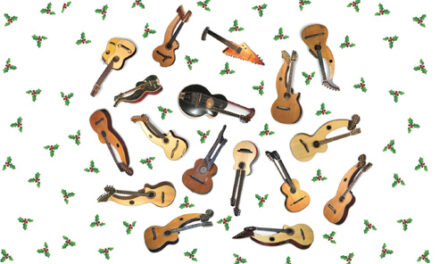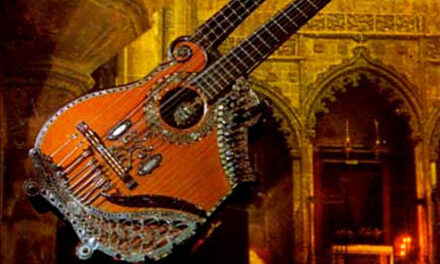
And I’m sure you’ll come up with some other names yourself after examining the featured instruments.
It all started years ago, probably at the inception of Harpguitars.net. That’s when the Form Galleries opened up with every HG type (and relative) I knew of at the time, including photos from all my friends and associates. According to my records, the photo at left came from Benoît Meulle-Stef, and I later changed the file name to include the apparent source of the image, the (equally mysterious) Stearns Collection in Michigan. It may still be there, I don’t know (I should probably find out, and what they know about it). I’m not sure why I even included it in the Form 1a Gallery as an official harp guitar, as it hardly even resembles a guitar. I suppose because it does have 6 strings on the neck? Anyway, it was the only image we had, and I’ve never given it much thought.

Then a couple months ago, James Westbrook (early guitar scholar and author) sent me a link to the new image at left, and I thought “Cool, a better image of that strange organic harp guitar!” I filed it away for later, noting that it was from the Germanisches Nationalmuseum, in Nürnberg. It is described as “Guitar with bass-strings, late 18th or early 19th century.” I didn’t look for differences until just now.
What spurred me on was that this weekend I started to prep my modular bookshelf logistics in our new office, and (considering moving the music books in there) chose the tallest book I have to start at the bottom. That turned out to be a thin paperback (but over 14” tall), translated from an original Italian publication of 1990. As one is wont to do, I quickly thumbed through as I walked, and lo and behold, what should pop out but this?
(I thought I exhausted all my library info and images when I did Phase 1 of the site, but I guess I have to go back now and check!) I thought “Hey, it’s that weird instrument again!” – but in incredible detail this time. Except after checking, it was clearly different from the other. Make that “others.”
Yes, they are three, nearly identical, “one-of-a-kind” instruments! This specimen is from the Castle Museum in Milan. The author described it as “a peculiar Russian/Asiatic guitar belonging to the family of the bandura.” I don’t know that I’d agree with that assessment – I suppose there’s a vague vibe of the family of kobzas, torbans and the like. This one has what seems to be a sinuous dragon forming the head and “tail” of the instrument. Seems more Oriental to me. Interesting…Jim Westbrook described the one he forwarded as “an English cittern (Preston) body and fingerboard which has been influenced by a Chinese Salvador Dali.”
Nor does the original specimen at top appear to have a creature carved into it. There are slight differences and embellishments between the three (perhaps the decorated soundboard of the last one provides a clue as to its origin…?). But, curiously, what they all have in common is this very specifically shaped and formed wooden body, which as my title infers, makes me wonder if the builder patterned it off of some local gourd – either that or some weird snail, or perhaps shelled sea creature.
They also have very consistent stringing – 6 on the neck, with 3 floating (some have the neck tuners inserted into the back of the carved head, so are not visible). The fretboards appear modern and playable, with metal frets on the last one, but what looks like gut for the second one. Were these tuned like a guitar or some other folk instrument? The gut strings, crude tuners and general workmanship suggest to me that these could be some sort of traditional instrument from some unknown part of the world. As does the stringing consistency. Or could they be just a creative specialized design by a single builder?!
Chinese? Ukrainian? European? (2 in collections there) Or American? (an early Fred Carlson with a strange sense of humor?) Harp guitars, or alternately-tuned folk instruments?
Thoughts? These gourd-snail-dragon thingys are driving me crazy!






